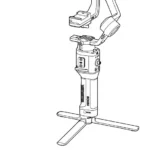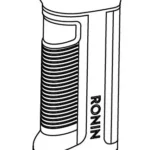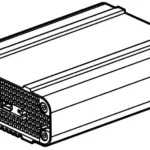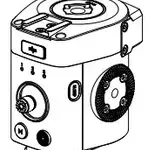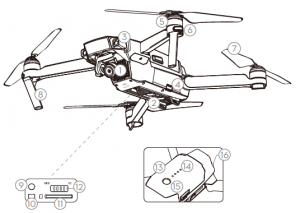
dji Mavic Pro Quadcopter with Remote Controller User Guide
The DJITM MAVICTM Pro is DJI’s smallest flying camera, featuring a fully stabilized camera, Intelligent Flight Modes and Obstacle Avoidance inside a revolutionary folding design. It captures 4K videos and 12 megapixel photos, and is capable of both ActiveTrackTM and TapFlyTM making complex shots effortless.
Mavic Pro boasts a maximum flight speed of 40 mph (65 kph) and a maximum flight time of 27 minutes*.

- Gimbal and Camera
- Downward Vision System
- Forward Vision System**
- Micro USB Port
- Motors
- Front LEDs
- Propellers
- Antennas
- Link Button
- Linking Status Indicator
- Camera Micro SD Card Slot
- Control Mode Switch
- Intelligent Flight Battery
- Battery Level LEDs
- Power Button
- Aircraft Status Indicator
- Maximum flight time was tested in 0 wind at a consistent 5 mph (25 kph). This value should be taken for reference only.
* The Forward Vision System is affected by surrounding conditions. Read the Disclaimer and Safety Guidelines and watch the tutorial in the DJI GOTM 4 app or on the Official DJI website to learn more. http://www.dji.com/mavic
Built into the Remote Controller is DJI’s latest long-range transmission technology OCUSYNCTM, offering a maximum transmission range of 4.3 mi (7 km). An on-board LCD screen keeps you updated on aircraft data, and video from the aircraft to the DJI GO 4 app on your mobile device at up to 1080p at close range, and 720p at longer ranges.
The Mavic Pro can also be flown by phone only. Maximum run-time: 2.5 hours*
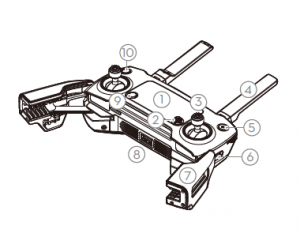
- LCD Screen
- 5D Button
- Control Sticks
- Antennas
- Power Button
- Flight Mode Switch
- Mobile Device Clamp
- USB Port
- Flight Pause Button
- RTH Button
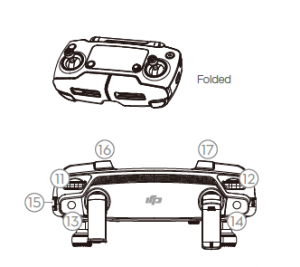
- Gimbal Dial
- Camera Settings Dial
- Record Button
- Shutter Button
- Power Port (Micro USB)
- C1 Button (customizable)
- C2 Button (customizable)
- The remote controller is able to reach its maximum transmission distance (FCC) in a wide open area with no Electro-Magnetic Interference, and at an altitude of about 400 feet (120 meters). The maximum run-time is tested under laboratory environment, only for your reference.
- Aircraft
Weight 1.62 lbs (734 g)
Weight (including gimbal cover)1.64 lbs (743 g)
Max Ascent Speed 16.4 ft/s (5 m/s) in Sport Mode Max Descent Speed 9.8 ft/s (3 m/s)
Max Speed 40 mph (65 kph) in Sport Mode without wind
Max Service Ceiling Above
Sea Level 16404 feet (5000 m)
Max Flight Time 27 minutes (0 wind at a consistent 15.5 mph (25 kph))
Max Hovering Time 24 minutes (0 wind)
Max Flight Distance 8 mi (13 km, 0 wind)
Operating Temperature 32° to 104° F (0° to 40° C) Satellite Positioning Systems GPS/GLONASS
- Gimbal
Controllable Range Pitch: -90° to +30°, Roll: 0°or 90° (Horizontally and vertically) - Forward Vision System
Sensing Range Precision measurement range: 2 ft (0.7 m) to 49 ft (15 m)
Detectable range: 49 ft (15 m) to 98 ft (30 m)
Operating Environment Surfaces with clear patterns and adequate lighting (lux > 15) - Downward Vision System
Velocity Range ≤ 22.4 mph (36 kph) at 6.6 ft (2 m) above ground
Altitude Range 1 – 43 feet (0.3 – 13 m)
Operating Range 1 – 43 feet (0.3 – 13 m)
Operating Environment Surfaces with a clear patterns and adequate lighting (lux > 15)
Velocity Range ≤ 22.4 mph (36 kph) at 6.6 ft (2 m) above ground
Altitude Range 1 – 43 feet (0.3 – 13 m)
Operating Range 1 – 43 feet (0.3 – 13 m)
Operating Environment Surfaces with a clear patterns and adequate lighting (lux > 15) - Camera
Sensor 1/2.3” CMOS Effective pixels:12.35 Megapixels (Total pixels: 12.71 M)
Lens 78.8° FOV, 28 mm (35 mm format equivalent) f/2.2 Distortion <1.5% Focus from 0.5 m to ∞
ISO Range 100 – 3200 (video), 100 – 1600 (photo) Electronic Shutter Speed 8 s to 1/8000 s
Max Image Size 4000×3000
Still Photography Modes Single shot
Burst shooting: 3/5/7 frames Auto Exposure Bracketing (AEB):
3/5 bracketed frames at 0.7EV Bias Interval HDR - Video Recording Modes C4K: 4096×2160 24p, 4K: 3840×2160 24/25/30p 2.7K: 2720×1530 24/25/30p FHD: 1920×1080 24/25/30/48/50/60/96p HD: 1280×720 24/25/30/48/50/60/120p
Video Storage Bitrate 60 Mbps
Supported File Systems FAT32 (≤ 32 GB), exFAT (> 32 GB) Photo JPEG, DNG
Video MP4, MOV (MPEG-4 AVC/H.264)
Supported SD Cards microSDTM. Max capacity: 64 GB Class 10 or UHS-1 rating required - Remote Controller
Operating Frequency 2.4 GHz to 2.4835 GHz Max Transmission Distance FCC Compliant: 4.3 mi (7 km); CE Compliant: 2.5 mi (4 km) Unobstructed and free of interference.
Operating Temperature 32° to 104° F (0° to 40° C)
Battery 2970 mAh
Transmitter Power (avg. EIRP) FCC: ≤ 26 dBm; CE: ≤ 20 dBm Operating Voltage 950 mA @ 3.7 V Supported Mobile Device Size Thickness supported: 6.5 – 8.5 mm, Max length: 160 mm Supported USB port types: Lightning, Micro USB (Type-B), USB Type-CTM - Charger
Voltage 13.05 V
Rated Power 50 W - Intelligent Flight Battery
Capacity 3830 mAhVoltage 11.4 VBattery Type LiPo 3SEnergy 43.6 Wh
Net Weight Approx. 0.5 lbs (240 g) Charging Temperature Range 41° to 104° F (5° to 40° C) Max Charging Power 100 W
2. Check the Battery Levels
Press once to check the Press once to check the battery level on
battery level. Press once, then LCD screen. Press once, then again and
again and hold to turn on/off. hold to turn on/off the remote controller
2. Charge the Batteries
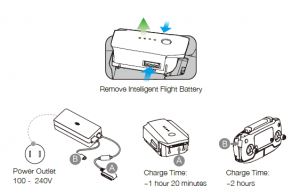
4. Prepare the Remote Controller
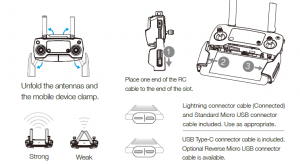

- Choose an appropriate RC Do not twist the RC cable.
- The RC cable slider must be replaced if using a USB Type-C RC Refer to the User Manual for RC Cable connection.
5. Prepare the Aircraft


- Unfold the front arms and the propellers before the rear All arms and propellers must be unfolded before takeoff.
- The gimbal cover is used to protect the gimbal. Remove it when necessary
6. Prepare for Takeoff
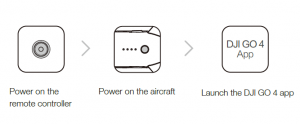


- The Mavic Pro can be controlled using the Remote Controller or Virtual Joysticks. Select control modes by toggling the Control Mode Switch. Only toggle this switch when the aircraft is powered off
7. Flight
The default flight control is known as Mode 2. The left stick controls the aircraft’s altitude and heading, while the right stick controls its forward, backward, left and right movements. The gimbal dial controls the camera’s tilt.
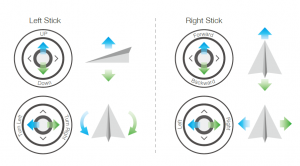
Before taking off, make sure the Aircraft Status Bar in the DJI GO 4 app or on the Remote Controller LCD screen displays ‘Ready to Go’.
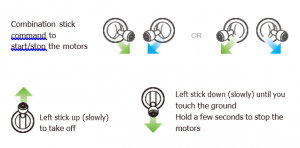

- The motors can only be stopped mid-flight when the flight controller detects critical error.
Controlling flight with Virtual Joysticks on your mobile device via Wi-Fi

- Toggle the Control Mode Switch to turn on Wi-Fi
- Power on the aircraft
- Launch the DJI GO 4 app and tap the icon on the top right of your screen, then scan the Wi-Fi QR Code on the front arm to start connection
- Tap Auto Takeoff
- Fly the aircraft with touch control

- Turn on your mobile device’s Wi-Fi and enter the Wi-Fi password shown on the front arm to connect to the Mavic network if for any reason you cannot scan the QR
- When using Wi-Fi in a wide open area with no Electro-Magnetic Interference, transmission distance is approximately 262 ft (80 m) at an altitude of 164 ft (50 m)
- The Wi-Fi frequency of your mobile device can be set to 4 Ghz or 5 Ghz. Set your Wi-Fi to 5 Ghz for less interference. Once connected to the Mavic Pro, you can change your Wi-Fi password or reset your Wi-Fi connection. (Refer to the User Manual for more information)
In the DJI GO 4 App


- Watch the tutorial in the DJI GO 4 app or on the Official DJI website to learn more.
- Always set an appropriate RTH altitude before When the aircraft is returning to the Home Point, you should guide it with the control sticks.
8. Fly Safe


Avoid flying over or near obstacles, crowds, high voltage power lines, trees or bodies of water.
DO NOT fly near strong electromagnetic sources such as power lines and base stations as it may affect the onboard compass.

DO NOT use the aircraft in adverse weather conditions such as rain, snow, fog and wind speeds exceeding 10 m/s or 22 mph.


